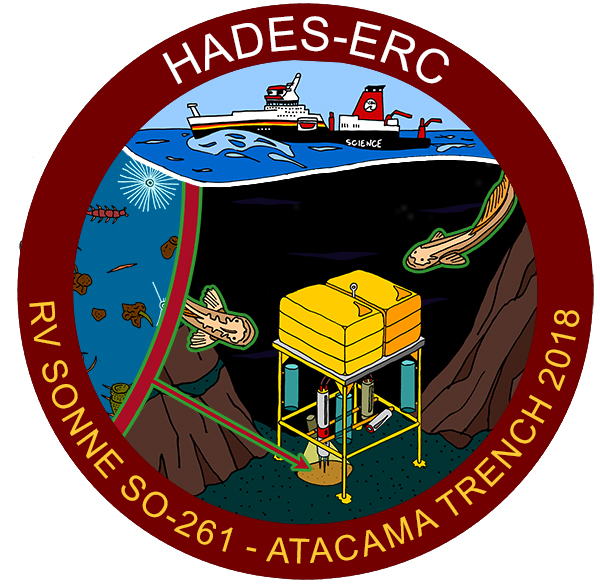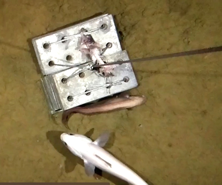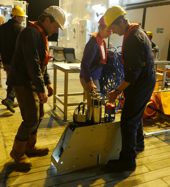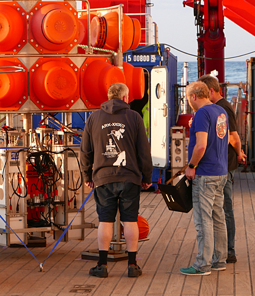- Press Office
- Blogs and More
- Right next to the Atacama Trench - Blogpost 2 from RV SONNE, March 7, 2018
Right next to the Atacama Trench - Blogpost 2 from RV SONNE, March 7, 2018
On board RV SONNE, Chile
Wednesday, March 7, 2018
Yes, we are defintely making progress. After a short stopover in the harbor of Mejillones, where we received the last parcels with scientific equipment, we arrived at 23 ° 48.725 S and 70 ° 50.94 W - the first of our sampling sites. It is located on the abyssal plane at 2550 meters, right next to the Atacama Trench. Yesterday and the day before we were able to study the seabed with special camera systems.
Who is living in the water column?
The cameras deployed showed which kind of fish is living here. The research group led by Alan Jamieson with Heather Stewart of the British Geological Survey, Mackenzie Gerringer of the University of Washington, and Thomas Linley of Newcastle University lured the deep-sea creatures with a bait. The sediment at 2550 meters depth swirled up as the REIVER lander system hit the bottom. It took only minutes before the first deep-sea creatures curiously followed the irresistible smell and came into the camera's range. Alan´s team wants to find out which species live in which depths. The fish has to be adapted so that their metabolism and thus their enzymes still function at high pressures - for example, 800 bar in a depth of 8000 meters. Only well adapted specialists can do that. The scientists want to find out which survival strategy these species have developed during their evolution.
What happens in the upper layers of sediment?
It took more than three days to assemble the almost four-meter high FLUX-Lander. Axel Nordhausen and Volker Asendorf from the Max Planck Institute for Marine Microbiology in Bremen are keeping track of hundreds of joints, screws and watertight electronic connections that are necessary for the device to do its job in the deep sea.
Axel and Volker belong to the group of Chief Scientist Frank Wenzhöfer from the Max Planck Institute in Bremen. Their aim is to investigate processes in the top ten centimeters of the sediment. There, an important step of the carbon cycle takes place: microorganisms digest the dead organic matter constantly sinking down from the upper layers as marine snow. While digesting, they consume oxygen. With the sensors in the FLUX lander it is possible to follow this process directly at the bottom of the deep sea (“in-situ”). After the lander has reached the seefloor, three sampling chambers are hydraulically driven 25 centimeters deep into the seafloor. There they seal themselves and thus enclose a defined body of water. Inside the chambers, oxygen sensors record the decrease in oxygen concentration over time. At precisely defined timepoints, the lander system will additionally extract 50 milliliters of bottom seawater for later analysis of nutrients.
Once they know the rate with which levels of oxygen, hydrogen sulfide and nutrients such as nitrate, phosphate or ammonium change, Frank Wenzhöfer and his fellow researchers can derive important process parameters of the respective habitat. In a parallel experiment, sensors measure how oxygen is distributed throughout the top ten centimeters of the sediment. The oxygen present there originally comes from the water column. It can penetrate into the sediment, where it is consumed by microbiological processes. With increasing depth, oxygen concentration decreases. When plotting this curve, the fluxes can be calculated. The working hypothesis is that in the deep-sea trenches, the curve slopes more steeply than in the adjacent abyssal plane. This means that the deep-sea trenches are more active than the abyssal plane. And this hypothesis has to be checked.
Warm greetings from the Sonne,
Manfred Schlösser
Specific questions addressed during this cruise are:
- What are the sedimentary processes providing food for the hadal community in the Atacama Trench?
- How do abundance, diversity and community structure of microorganisms, meio- and macrofauna in the Atacama Trench differ from those in less productive trenches and nearby abyssal and shelf sites?
- What are the general biogeochemical characteristics of the surface and deep sediment and water column in the eutrophic Atacama Trench?
- Which mineralization pathways are responsible for organic matter breakdown in the eutrophic Atacama Trench?
- How efficient are microbial communities operating at extreme hydrostatic pressures in mineralizing organic material as compared to their shallower counterparts? And to what extent do specialized, yet unknown extremophile microbial communities mediate these processes?
Further information
More details about the project from the University of Southern Denmark.
More pictures related to the project.
Ronnie N Glud at Danmarks Radio (in Danish)
RV SONNE is a modern German research vessel sailing mainly in the Pacific Ocean.
More information about the ship here.




